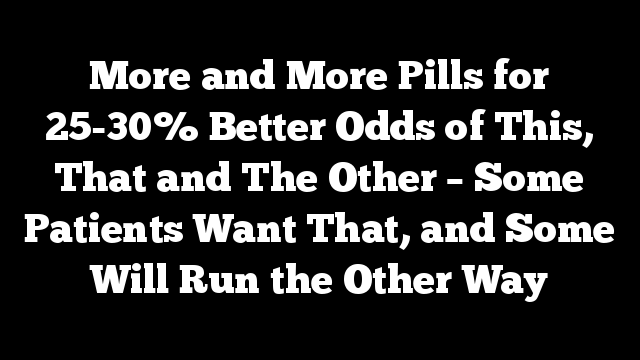
By HANS DUVEFELT, MD
I scribbled my signature on a pharmaceutical rep’s iPad today for some samples of Jardiance, a diabetes drug that now has expanded indications according to the Food and Drug Administration. This drug lowers blood sugar (reduces HbA1c by less than 1 point) but also reduces diabetes related kidney damage, heart attacks, strokes and now also admission rates for heart failure (from 4.1% to 2.7% if I remember correctly – a significant relative risk reduction but not a big absolute one; the Number Needed to Treat is about 70, so 69 out of 70 patients would take it in vain for the heart failure indication. The NNT for cardiovascular death is around 38 over a three year period – over a hundred patient years for one patient saved). There are already other diabetes drugs that can reduce cardiovascular risk and I see cardiologists prescribing them for non-diabetics.
It’s a bit of a head scratcher and it makes me think of the recently re-emerged interest in the notion of a “Polypill” with several ingredients that together reduce heat attack risk. The tested Polypill formulations are all very inexpensive, which is a big part of their attraction. Jardiance, on the other hand, costs about $400 per month.
The “rep” asked whether this medication would be something I’d be likely to discuss with my diabetic patients.
“Well, you know I’ve only got fifteen minutes…” dampened his expectations. But I told him about the Polypill studies. I think patients are still not ready to make the distinction between on the one hand medications that treat a more or less quantifiable problem like blood sugar levels, blood pressure or the much less straightforward lipid levels and on the other hand ones that only change statistical outcomes. Most of my patients have trouble wrapping their head around taking a $400 a month pill that doesn’t make them feel better or score a whole lot better on their lab test but only changes the odds of something most people think will never happen to them anyway.
I’m a simple minded person in some ways, I guess, but it helps me in my patient interactions to distinguish between what we know with decent certainty and what we think is a good probability and also between what tangible benefit a treatment can be expected to offer as opposed to just some statistical advantage that means nothing if you draw the shorter straw.
It almost makes sense to think of a two tiered approach to healthcare: some people truly want every statistical advantage and pharmaceutical intervention possible while others just want to treat what they can see or measure, and I think we have to figure out where each patient falls on the spectrum between those opposites, or we will overwhelm and lose patients and see them give up on everything we might have to offer.
Whichever approach patients take requires their commitment and determination and we need to listen carefully for clues about their beliefs and willingness to treat. There’s no point in prescribing anything in a half hearted way, because treatment adherence isn’t likely to be very good then. And doing a hard sell to a disinclined patient in fifteen minutes along with many other things we need to cover is a pipe dream and a guaranteed turnoff.
So, and this is a thought I’ve developed working with horses: Doctors shouldn’t be horse whisperers, nor should horse people. People have looked at this from the wrong vantage point. You don’t whisper to the horse so it will do what you want – you must first listen to the horse, and then, once you know how the horse feels about things, you can whisper your suggestion. And because the horse trusts you and knows you’d never suggest anything that is completely against its nature, the horse is likely to follow your low key, “whispered” suggestion better than a harsh command.
But listening comes before whispering, in horsemanship and in healthcare.
Hans Duvefelt is a Swedish-born rural Family Physician in Maine. This post originally appeared on his blog, A Country Doctor Writes, here.
The post More and More Pills for 25-30% Better Odds of This, That and The Other – Some Patients Want That, and Some Will Run the Other Way appeared first on The Health Care Blog.
